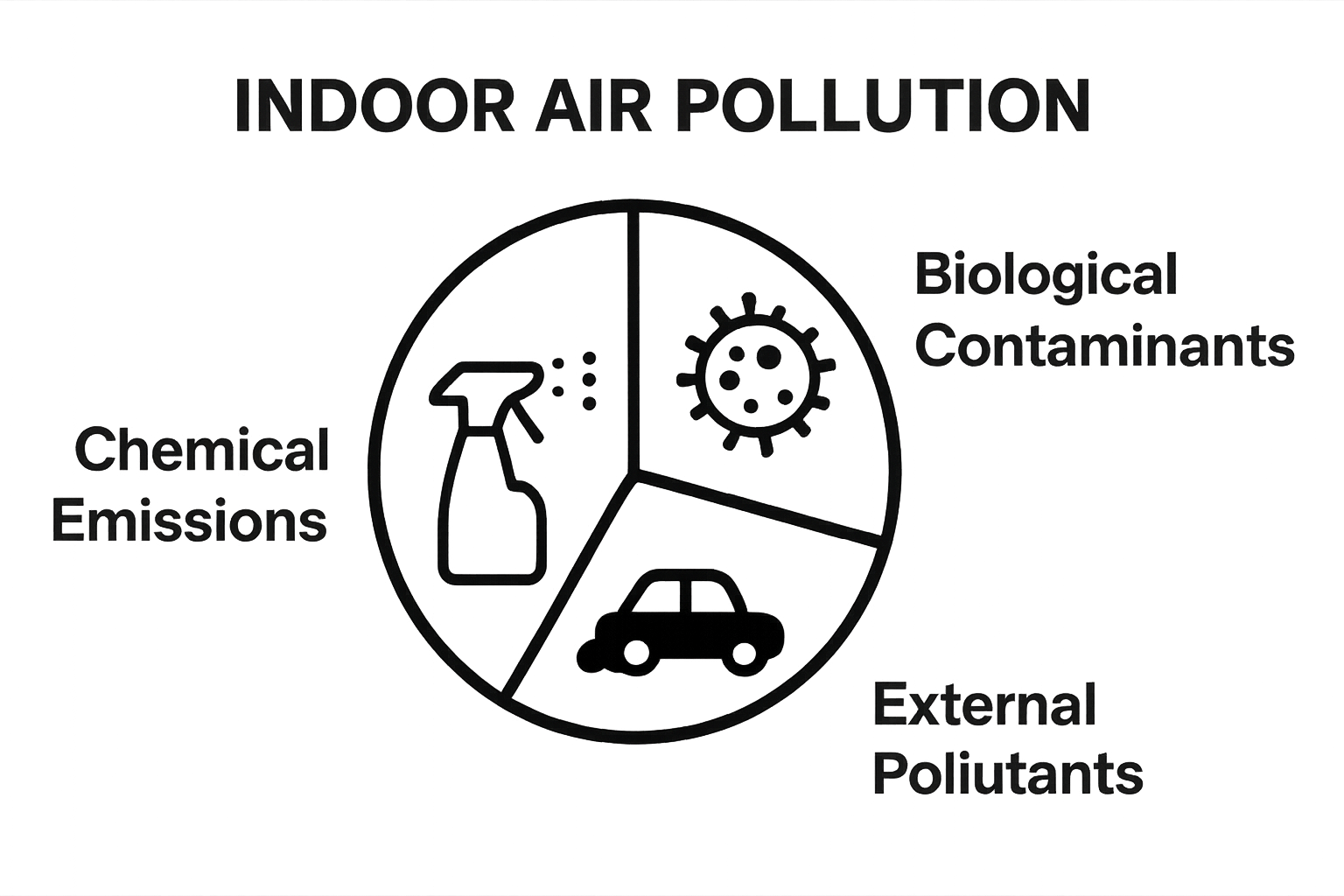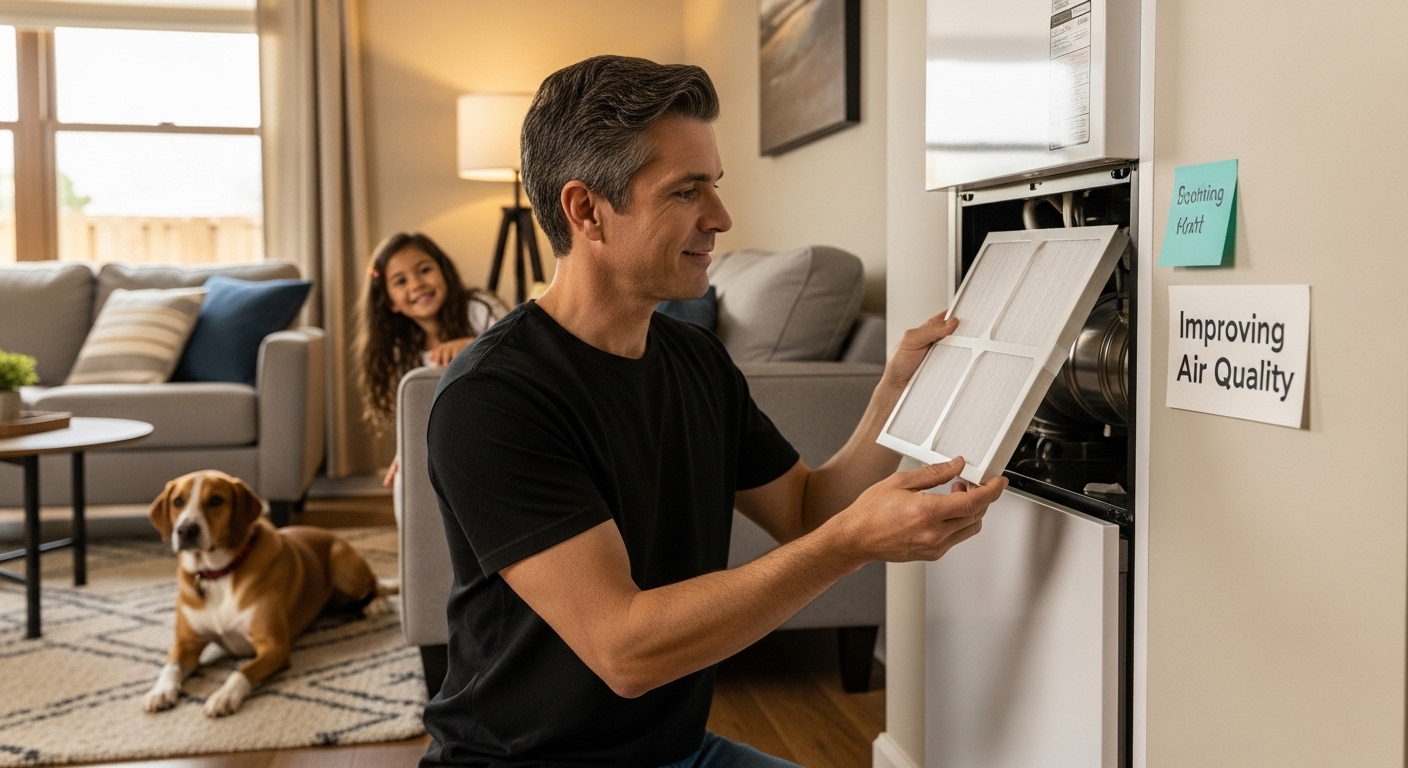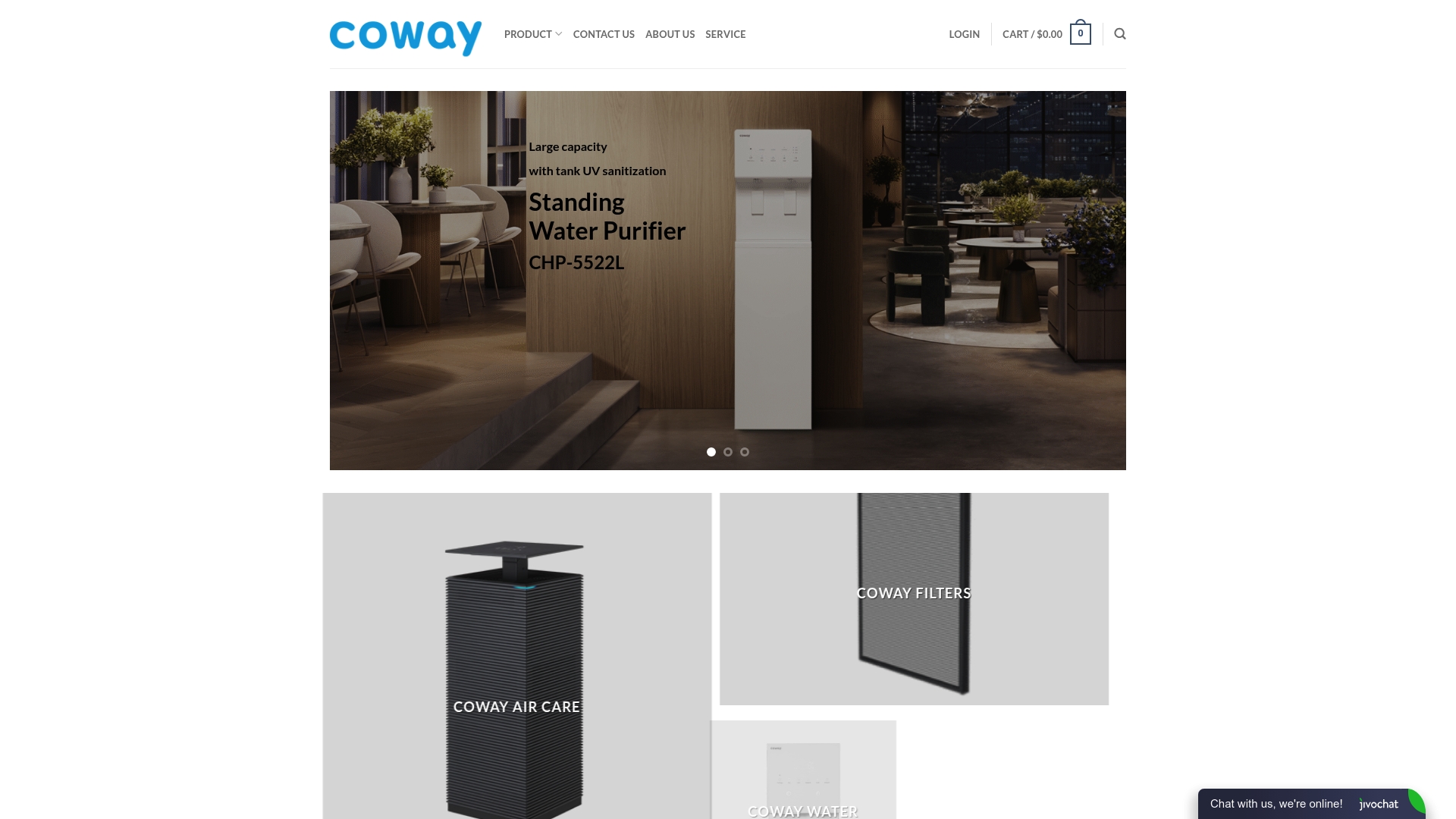Uncategorized
Understanding Why Indoor Air Quality Matters
Every day you breathe roughly 20,000 times inside your home, office, or school and think nothing of it. Most people assume indoor air is cleaner than what’s outside. But the truth is, indoor air pollutant levels can be 2 to 5 times higher than outdoor air according to the EPA, and sometimes even more. What you cannot see floating around you could quietly shape how you feel, work, and even how you think.
Table of Contents
- Defining Indoor Air Quality: What It Is
- The Importance Of Indoor Air Quality For Health
- How Indoor Air Quality Affects Comfort And Productivity
- Key Factors That Influence Indoor Air Quality
- Practical Solutions For Improving Indoor Air Quality
Quick Summary
| Takeaway | Explanation |
|---|---|
| Indoor air quality affects health significantly. | Poor indoor air quality can lead to respiratory issues, fatigue, and long-term diseases over time. |
| Recognize common indoor pollutants. | Everyday items like cleaning products, cooking fumes, and furniture can introduce harmful air contaminants. |
| Improve ventilation for better air quality. | Effective ventilation helps remove pollutants and brings in fresh air, reducing indoor contamination levels. |
| Vulnerable populations need special attention. | Children, elderly individuals, and those with respiratory conditions are at higher risk from poor air quality. |
| Source control is key for cleaner air. | Reducing pollution at the source through low-emission products and regular cleaning can significantly improve indoor air quality. |
Defining Indoor Air Quality: What It Is
Indoor air quality represents the environmental conditions within buildings and enclosed spaces that directly impact human health, comfort, and overall well being. When we talk about why indoor air quality matters, we are essentially examining the invisible atmosphere surrounding us every day, which can significantly influence our respiratory health and general wellness.
Understanding the Fundamental Concept
The U.S. Environmental Protection Agency defines indoor air quality as the characteristics of air inside structures that relate to human health and comfort. This comprehensive definition encompasses multiple factors that contribute to the air we breathe indoors, including:
- Chemical pollutants from building materials
- Biological contaminants like mold and bacteria
- Particulate matter from external and internal sources
- Gases and volatile organic compounds (VOCs)
These elements interact in complex ways, creating an environmental profile that can either support or compromise human health. The composition of indoor air is not static but constantly changing based on ventilation, external environmental conditions, and human activities.
Sources of Indoor Air Contaminants
Contrary to common perception, indoor spaces are not inherently clean. Multiple sources continuously introduce potential pollutants into our immediate environment. Everyday activities and household items can generate significant air quality challenges. Cooking processes release microscopic particles, cleaning products emit chemical vapors, furniture and carpets slowly outgas synthetic compounds, and personal care products contribute additional chemical loads.
Furthermore, external factors like outdoor pollution, construction materials, and even human breath contribute to the intricate ecosystem of indoor air. Understanding these dynamics helps individuals make informed decisions about maintaining healthier indoor environments.
The following table categorizes the primary sources of indoor air pollutants and provides an example and potential health impact for each.
| Source Category | Example | Potential Health Impact |
|---|---|---|
| Building Materials | Paints, adhesives, flooring | Headaches, respiratory irritation |
| Household Cleaning Products | Spray disinfectants, detergents | Asthma, eye/throat irritation |
| Combustion Processes | Cooking stoves, fireplaces | Increased respiratory illnesses |
| Biological Contaminants | Mold, pet dander, pollen | Allergies, asthma attacks |
| Personal Care Products | Perfumes, hair sprays | Allergic reactions, headaches |
| External Pollutants | Outdoor car exhaust, smog entering | Aggravated existing conditions |
| Human Activities | Breathing, movement | Elevated carbon dioxide levels |
By recognizing the multifaceted nature of indoor air quality, we can take proactive steps to monitor, manage, and improve the air we breathe daily. This awareness is crucial for protecting personal health and creating living spaces that genuinely support human wellness.
The Importance of Indoor Air Quality for Health
Understanding why indoor air quality matters goes far beyond mere comfort. It represents a critical aspect of human health that directly impacts our respiratory system, overall wellness, and long-term physiological functioning. Poor indoor air quality can silently contribute to numerous health challenges, making it a crucial factor in personal and public health management.
Immediate and Long-Term Health Impacts
Research from the Environmental Protection Agency reveals that Americans spend approximately 90 percent of their time indoors, where air pollutant concentrations can be 2 to 5 times higher than outdoor levels. These concentrated environments can trigger a range of health consequences, including:
- Acute symptoms like eye and respiratory tract irritation
- Headaches and persistent fatigue
- Increased risk of respiratory infections
- Potential exacerbation of existing chronic conditions
Prolonged exposure to indoor air pollutants can lead to more serious health complications.
This table summarizes the immediate and long-term health impacts of poor indoor air quality as described in the article.
| Time Frame | Potential Impact |
|---|---|
| Immediate | Eye and respiratory tract irritation |
| Immediate | Headaches and persistent fatigue |
| Immediate | Increased risk of respiratory infections |
| Long-Term | Exacerbation of chronic respiratory conditions |
| Long-Term | Increased risk of cardiovascular problems |
| Long-Term | Potential long-term neurological impacts |
Vulnerable Populations and Higher Risks
Certain demographic groups experience more significant health risks from compromised indoor air. Children, elderly individuals, and people with pre-existing respiratory conditions like asthma or allergies are particularly susceptible to air quality variations. Their physiological systems are more sensitive to environmental pollutants, making indoor air quality not just a comfort issue, but a critical health consideration.
Moreover, indoor spaces like homes, offices, and educational institutions can become breeding grounds for potential health risks if air quality is not properly managed. The invisible nature of these pollutants makes them particularly insidious, as individuals may not immediately recognize the environmental challenges surrounding them.
Recognizing and addressing indoor air quality is not merely a preventative measure but a proactive approach to maintaining comprehensive personal health.
By understanding the intricate relationship between our indoor environments and our physiological well-being, we can make informed decisions that protect and enhance our overall quality of life.
How Indoor Air Quality Affects Comfort and Productivity
Indoor air quality transcends physical health, directly influencing human comfort, cognitive performance, and overall workplace or home productivity. The invisible atmospheric conditions surrounding us play a profound role in our daily mental and physical capabilities, making it essential to understand how environmental factors impact our functional effectiveness.
Cognitive Performance and Environmental Conditions
Scientific research published in the International Journal of Environmental Research and Public Health demonstrates that indoor air quality significantly influences cognitive performance. Poor air quality can lead to decreased mental clarity, reduced concentration, and diminished problem-solving abilities. The relationship between air quality and cognitive function is more intricate than most people realize.
Key cognitive impacts of suboptimal indoor air include:
- Reduced mental processing speed
- Decreased attention span
- Increased mental fatigue
- Impaired decision-making capabilities
Workplace and Living Space Dynamics
In professional environments, indoor air quality becomes a critical factor affecting employee performance and organizational productivity. Spaces with poor ventilation, high pollutant concentrations, and inadequate air circulation can create an environment that suppresses worker efficiency and increases potential health-related absenteeism.
The comfort aspect of air quality extends beyond mere temperature control. Factors like humidity levels, particulate matter concentration, and chemical compound presence contribute to an individual’s sense of physical and psychological comfort. When these elements are balanced, people experience enhanced well-being, leading to improved mood, higher energy levels, and more consistent performance.
Recognizing indoor air quality as a holistic system rather than an isolated factor empowers individuals and organizations to create environments that support optimal human functioning. By understanding and implementing strategies to improve air quality, we can transform our indoor spaces into zones of enhanced comfort, productivity, and overall well-being.
Key Factors That Influence Indoor Air Quality
Indoor air quality is a complex ecosystem influenced by multiple interconnected elements that continuously interact within our living and working environments. Understanding these factors is crucial for creating healthier indoor spaces and mitigating potential health risks associated with poor air quality.
Sources of Indoor Air Pollutants
The U.S. Environmental Protection Agency identifies numerous sources that contribute to indoor air contamination. These pollutant sources range from visible to completely invisible elements that can significantly impact atmospheric composition. The primary categories of indoor air pollution sources include:

- Chemical emissions from building materials
- Household cleaning and personal care products
- Combustion processes like cooking and heating
- Biological contaminants such as mold and pet dander
- External pollutants infiltrating indoor spaces
Each of these sources introduces unique chemical and particulate compounds that can alter the delicate balance of indoor air composition, potentially compromising respiratory health and overall environmental quality.
Ventilation and Air Exchange Dynamics
Ventilation plays a critical role in maintaining indoor air quality by facilitating continuous air exchange between indoor and outdoor environments. Inadequate ventilation can lead to pollutant accumulation, creating stagnant air environments where contaminants become concentrated. Proper air circulation helps dilute and remove potentially harmful particulates, gases, and microorganisms.
Factors like building design, window placement, mechanical ventilation systems, and geographic location significantly influence air exchange rates. Modern buildings with sealed environments often require deliberate ventilation strategies to ensure healthy air circulation, as natural air movement becomes increasingly restricted by contemporary architectural designs.
Recognizing these intricate factors empowers individuals to take proactive measures in managing their indoor environments. By understanding the sources and dynamics of indoor air quality, we can implement targeted strategies that promote healthier, more comfortable living and working spaces.
Practical Solutions for Improving Indoor Air Quality
Addressing indoor air quality requires a strategic, multi-dimensional approach that combines technological solutions, environmental modifications, and proactive maintenance. By implementing targeted interventions, individuals can significantly transform their indoor atmospheric conditions and create healthier living and working environments.
Source Control and Pollution Reduction
The U.S. Environmental Protection Agency recommends source control as the most direct method for improving indoor air quality. Eliminating or minimizing pollution sources represents the most effective and cost-efficient strategy for creating cleaner indoor environments. Practical steps include:
- Selecting low-emission building materials
- Using natural cleaning products
- Avoiding indoor smoking
- Maintaining proper humidity levels
- Regularly cleaning and replacing air filters
These targeted interventions address pollution at its origin, preventing harmful compounds from circulating and accumulating within indoor spaces.
Ventilation and Air Circulation Strategies
Effective ventilation serves as a critical mechanism for diluting and removing indoor pollutants. Modern buildings often require deliberate air exchange strategies to counteract increasingly sealed architectural designs. Implementing comprehensive ventilation approaches involves integrating natural and mechanical systems that promote continuous air movement.
Mechanical ventilation systems, including high-efficiency particulate air (HEPA) filters and advanced air purification technologies, can dramatically improve indoor air quality. These systems work by capturing microscopic particles, neutralizing potential biological contaminants, and maintaining a consistent flow of fresh air throughout indoor environments.
Ultimately, improving indoor air quality is not a one-time intervention but an ongoing process of monitoring, adapting, and implementing targeted strategies. By understanding the complex interactions between environmental factors and air composition, individuals can create spaces that support respiratory health, enhance comfort, and promote overall well-being.
This concept comparison table outlines key differences between source control and ventilation strategies for improving indoor air quality.
| Strategy | Main Approach | Examples | Key Benefit |
|---|---|---|---|
| Source Control | Eliminate/reduce pollution at source | Low-emission products, no indoor smoking | Removes pollutants before spread |
| Ventilation | Increase air exchange and dilution | Mechanical systems, open windows | Dilutes and removes contaminants |
| Air Circulation Devices | Maintain flow, filter particulates | HEPA filters, air purifiers | Captures and decreases allergens |

Take Control of Your Air Quality for a Healthier Home
Now that you understand how indoor air quality can silently impact your health, comfort, and productivity, do not leave your well-being to chance. Invisible contaminants build up from everyday sources. They affect everything from your breathing to your focus. Your family deserves air that is clean and safe every day.

Discover how Coway air purifiers equipped with advanced multi-stage filtration and scientific purification technology can actively remove harmful particles and allergens from your home. Shop our bestselling purifiers now and experience the difference in every breath. Visit Coway’s home wellness solutions for healthy living you can feel. Take action today and create a healthier living space while supplies last.
Frequently Asked Questions
What is indoor air quality, and why does it matter?
Indoor air quality refers to the characteristics of the air inside buildings that impact human health and comfort. It matters because poor indoor air quality can lead to respiratory problems, headaches, and other serious health issues due to the presence of pollutants and contaminants.
What are common sources of indoor air pollutants?
Common sources of indoor air pollutants include chemical emissions from building materials, household cleaning products, biological contaminants like mold and bacteria, cooking and heating processes, and external pollutants that infiltrate indoor spaces.
How does indoor air quality affect productivity?
Indoor air quality directly affects productivity as poor air quality can impair cognitive functions such as concentration and problem-solving abilities, leading to reduced efficiency and increased fatigue in work and study environments.
What steps can I take to improve indoor air quality in my home?
To improve indoor air quality, you can use low-emission building materials, choose natural cleaning products, maintain proper humidity levels, ensure good ventilation through air exchange systems, and regularly clean and replace air filters.

